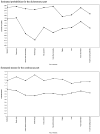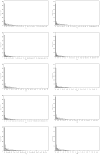Two-Part Factor Mixture Modeling: Application to an Aggressive Behavior Measurement Instrument
- PMID: 20717486
- PMCID: PMC2921717
- DOI: 10.1080/10705510903203516
Two-Part Factor Mixture Modeling: Application to an Aggressive Behavior Measurement Instrument
Abstract
This study introduces a two-part factor mixture model as an alternative analysis approach to modeling data where strong floor effects and unobserved population heterogeneity exist in the measured items. As the names suggests, a two-part factor mixture model combines a two-part model, which addresses the problem of strong floor effects by decomposing the data into dichotomous and continuous response components, with a factor mixture model, which explores unobserved heterogeneity in a population by establishing latent classes. Two-part factor mixture modeling can be an important tool for situations in which ordinary factor analysis produces distorted results and can allow researchers to better understand population heterogeneity within groups. Building a two-part factor mixture model involves a consecutive model building strategy that explores latent classes in the data for each part as well as a combination of the two-part. This model building strategy was applied to data from a randomized preventive intervention trial in Baltimore public schools administered by the Johns Hopkins Center for Early Intervention. The proposed model revealed otherwise unobserved subpopulations among the children in the study in terms of both their tendency toward and their level of aggression. Furthermore, the modeling approach was examined using a Monte Carlo simulation.
Figures






Similar articles
-
Folic acid supplementation and malaria susceptibility and severity among people taking antifolate antimalarial drugs in endemic areas.Cochrane Database Syst Rev. 2022 Feb 1;2(2022):CD014217. doi: 10.1002/14651858.CD014217. Cochrane Database Syst Rev. 2022. PMID: 36321557 Free PMC article.
-
Residual-Based Algorithm for Growth Mixture Modeling: A Monte Carlo Simulation Study.Front Psychol. 2021 Feb 26;12:618647. doi: 10.3389/fpsyg.2021.618647. eCollection 2021. Front Psychol. 2021. PMID: 33716885 Free PMC article.
-
Testing Measurement Invariance Across Unobserved Groups: The Role of Covariates in Factor Mixture Modeling.Educ Psychol Meas. 2021 Feb;81(1):61-89. doi: 10.1177/0013164420925122. Epub 2020 May 28. Educ Psychol Meas. 2021. PMID: 33456062 Free PMC article.
-
General growth mixture modeling for randomized preventive interventions.Biostatistics. 2002 Dec;3(4):459-75. doi: 10.1093/biostatistics/3.4.459. Biostatistics. 2002. PMID: 12933592
-
Latent variable mixture modeling in psychiatric research--a review and application.Psychol Med. 2016 Feb;46(3):457-67. doi: 10.1017/S0033291715002305. Epub 2015 Nov 3. Psychol Med. 2016. PMID: 26526221 Review.
Cited by
-
Toward Establishing a Standard Symptom Set for Assessing Sluggish Cognitive Tempo in Children: Evidence From Teacher Ratings in a Community Sample.Assessment. 2019 Sep;26(6):1128-1141. doi: 10.1177/1073191117715732. Epub 2017 Jun 25. Assessment. 2019. PMID: 28649849 Free PMC article.
-
Psychometric analysis and validity of the daily alcohol-related consequences and evaluations measure for young adults.Psychol Assess. 2017 Mar;29(3):253-263. doi: 10.1037/pas0000320. Epub 2016 May 19. Psychol Assess. 2017. PMID: 27196690 Free PMC article.
-
Heterogeneity in Trajectories of Child Maltreatment Severity: A Two-Part Growth Mixture Model.Violence Vict. 2015;30(5):916-32. doi: 10.1891/0886-6708.VV-D-13-00114. Epub 2015 Aug 21. Violence Vict. 2015. PMID: 26300381 Free PMC article.
-
Toward a model-based approach to the clinical assessment of personality psychopathology.J Pers Assess. 2014;96(3):283-92. doi: 10.1080/00223891.2013.830263. Epub 2013 Sep 5. J Pers Assess. 2014. PMID: 24007309 Free PMC article.
-
Optimal Items for Assessing Sluggish Cognitive Tempo in Children Across Mother, Father, and Teacher Ratings.J Clin Child Adolesc Psychol. 2019 Nov-Dec;48(6):825-839. doi: 10.1080/15374416.2017.1416619. Epub 2018 Feb 16. J Clin Child Adolesc Psychol. 2019. PMID: 29452000 Free PMC article.
References
-
- Boomsma A, Hoogland JJ. The robustness of LISREL modeling revisited. In: Cudeck R, du Toit S, Sörbom D, editors. Structural equation modeling: Present and future. Lincolnwood, IL: Scientific Software International; 2001. pp. 139–168.
-
- Brown EC, Catalano CB, Fleming CB, Haggerty KP, Abbot RD. Adolescent substance use outcomes in the Raising Healthy Children Project: A two-part latent growth curve analysis. Journal of Consulting and Clinical Psychology. 2005;73:699–710. - PubMed
-
- Duan N, Manning WG, Morris CN, Newhouse JP. A comparison of alternative models for the demand for medical care. Journal of Business and Economic Statistics. 1983;1:115–126.
-
- Jedidi K, Jagpal HS, DeSarbo WS. STEMM: A general finite mixture structural equation model. Journal of Classification. 1997;14:23–50.
-
- McLachlan GJ, Do KA, Ambroise C. Analyzing microarray gene expression data. New York: Wiley; 2004.
Grants and funding
LinkOut - more resources
Full Text Sources
Research Materials
